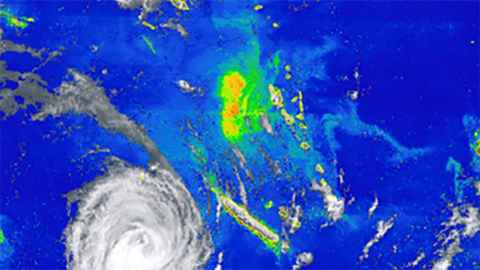Gigantic phytoplankton bloom could yield clues to climate future
24 March 2023
What roles may vast phytoplankton blooms play in ocean ecosystems? Dr Chris Horvat investigates.

Scientists studying a gigantic phytoplankton bloom triggered by a South Pacific tropical cyclone speculate traces of such events in the geological record could help reconstruct the frequency of cyclones in warmer bygone times.
That could give us a glimpse of our climate future.
Dr Christopher Horvat, of Waipapa Taumata Rua, University of Auckland, and Dr Pete Russell, of the University of Otago, investigated the effects in the upper ocean of Cyclone Oma near Vanuatu in 2019.
While Oma was a relatively benign cyclone, it left a massive phytoplankton bloom in its wake – the single most abnormal event in the history of South Pacific chlorophyll measurements, the researchers say.
The study published in Geophysical Research Letters found the bloom covering almost 250,000 kilometres of the ocean west of Vanuata was exceedingly rare, estimating that it would occur just once every 1,500 years in the same location.
These cyclones can do amazing things – other than have strong winds, they can also dramatically affect the plants and animals living in the upper ocean and change the cycling of carbon by leading to blooms
By examining sediment cores from the last inter-glacial period for evidence of blooms, it may be possible to reconstruct the frequency of tropical cyclones when oceans were warmer than they are now, the scientists suggest.
Ices sheets were smaller than today, seas higher, and temperatures warmer in the last inter-glacial, between 130,000 and 150,000 years before the present.
In their research, the scientists found if a storm hovers above a patch of ocean long enough, interactions between cyclone winds and ocean will cause water to rise near ithe cyclone's eye, bringing nutrient rich water to the surface, seeding a phytoplankton bloom.
Such an extreme event can produce a large amount of biomass in a part of the ocean that is typically a biological desert.
“These cyclones can do amazing things – other than have strong winds, they can also dramatically affect the plants and animals living in the upper ocean and change the cycling of carbon by leading to blooms," says Dr Horvat.
“Along with these bloom events in the open ocean, cyclone activity results in both coastal upwelling and runoff from the land that also deliver nutrients into the photic zone [the surface level of the ocean], generating blooms. These blooms could be an integral part of the local marine ecosystems of our Pacific neighbours, supporting higher food chains,” he says.
The researchers say they know too little about phytoplankton blooms to declare them either good or bad, but believe they may support open ocean ecosystems that are nutrient limited.
“We hope to investigate this further, in particular the influence on fisheries for Pacific islands,” Dr Horvat says.

Media contact
Paul Panckhurst | media adviser
M: 022 032 8475
E: paul.panckhurst@auckland.ac.nz